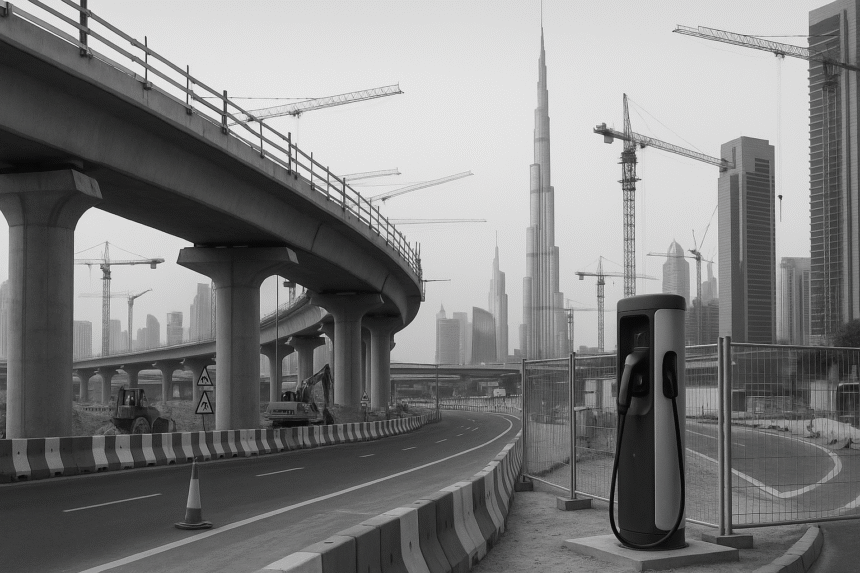Top Middle East Infrastructure Projects in 2025: What CEOs Need to Know
The Middle East infrastructure projects landscape in 2025 is more ambitious than ever. Driven by national visions, decarbonization goals, and massive urban expansions, governments across the region are investing heavily in transport, energy, mobility, and digital infrastructure.
For CEOs and business leaders in construction, EV supply, engineering, and urban mobility, understanding what’s underway—and what’s coming next—is crucial to making strategic moves in this fast-evolving market.
Why Infrastructure Is a Top Regional Priority in 2025
The GCC region alone is expected to witness over $1.3 trillion in active infrastructure investments by the end of 2025. Countries are using these mega-projects not just to modernize, but to position themselves as global innovation hubs in sustainability, tourism, logistics, and digital transformation.
Public-private partnerships (PPPs) and international contractors are playing a growing role in this transformation, especially in the UAE, Saudi Arabia, and Qatar.
Sector Breakdown: Where the Money Is Going
Here’s a sector-by-sector breakdown of the top infrastructure priorities reshaping the region:
Transport & Mobility
-
Riyadh Metro (Saudi Arabia): One of the world’s largest urban rail systems, with $22.5 billion in total investment.
-
Etihad Rail (UAE): Connecting the Emirates and extending into Oman for passenger and freight logistics.
-
Qatar Metro & Lusail Tram: Ongoing expansion to support urban density and the 2030 National Vision.
Energy & Clean Tech
-
NEOM’s ENOWA Hydrogen Plant: A $5 billion green hydrogen facility powering part of NEOM’s transport network.
-
UAE’s Barakah Nuclear Plant & Solar Expansion: Major contributors to clean energy goals, powering infrastructure growth.
-
Egypt’s Wind Corridor: New projects in the Gulf of Suez aim to power large industrial zones.
EV Integration
-
EV chargers are being integrated into airport expansions, new smart cities, and industrial zones.
-
Masdar City, The Line, and Lusail all prioritize EV-first infrastructure.
Government Spending Forecasts for 2025
National budgets reflect aggressive infrastructure strategies:
-
Saudi Arabia: The PIF has allocated over $170 billion for giga-projects in 2025 alone.
-
UAE: Dubai and Abu Dhabi together plan to invest over $30 billion in transportation, clean energy, and digital infrastructure.
-
Qatar: Spending on logistics, mobility, and energy continues post-World Cup, with $20+ billion in pipeline projects.
-
Oman and Bahrain: While on smaller scales, both countries are now accelerating road, port, and logistics infrastructure with GCC-backed financing.
Notable EV Integration in Mega-Projects
EV adoption is no longer isolated to vehicle sales—it’s embedded in how cities are built.
-
The Line (Saudi Arabia): Designed with zero-emission transport, including underground EV freight corridors.
-
Masdar (UAE): EV-ready grid systems and solar-integrated chargers.
-
Red Sea Project: Combines renewable power with a network of EV charging stations for resorts and logistics.
These projects are driving up demand for EV infrastructure suppliers, grid services, battery storage, and smart mobility apps.
Role of International Contractors
The 2025 outlook shows international players continuing to dominate large infrastructure packages, especially in joint ventures with local entities. Top firms active in the region include:
-
Bechtel (U.S.) – Rail, airport, and city masterplans
-
Jacobs (U.S.) – Sustainability design and energy projects
-
Hyundai E&C (South Korea) – Oil & gas infrastructure
-
ACCIONA (Spain) – Renewable energy and water projects
-
China State Construction – Urban and industrial zones
To win contracts, international firms are increasingly forming local partnerships to meet in-country value (ICV) requirements and align with national employment goals.
Key Trends for CEOs to Watch
-
Shift to modular construction for faster delivery and sustainability
-
Growing demand for smart grid and EV charging tech in mixed-use developments
-
Tighter tender scoring on ESG metrics
-
More BOT and DBFO (Design-Build-Finance-Operate) contracts instead of traditional EPCs
-
AI and BIM (Building Information Modeling) now mandatory for top-tier infrastructure packages in UAE and KSA
Conclusion: The Future Is Built Now
If your company works in engineering, EV charging, mobility, clean energy, or logistics—there’s never been a better time to enter or expand in the Middle East. The middle east infrastructure projects unfolding in 2025 are redefining the region’s global image, and CEOs who align early with national visions and execution timelines will be best positioned to lead.
Act now. Build relationships with government authorities, pre-qualify for tenders, and assess which projects align with your expertise. This is infrastructure as strategy.



Leave a Reply